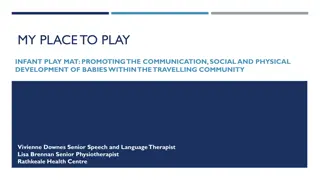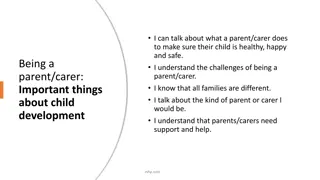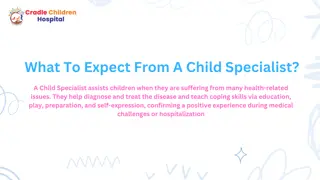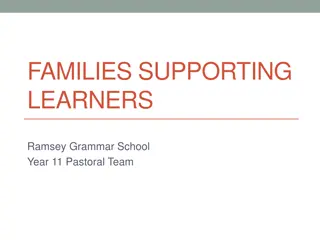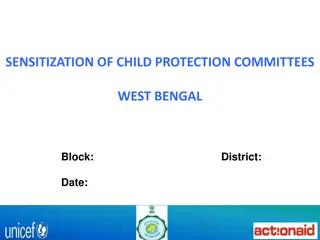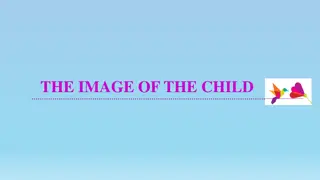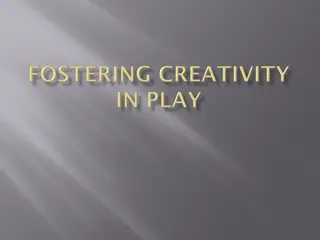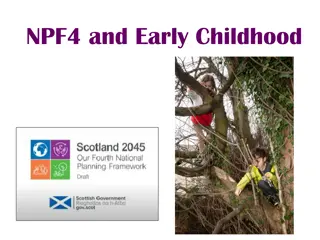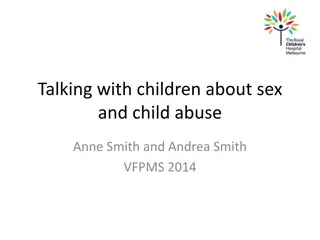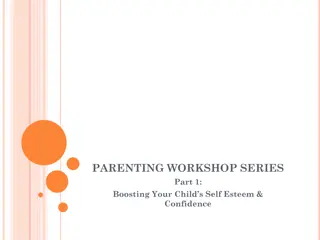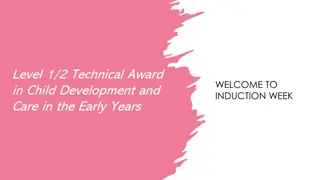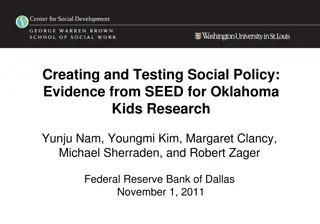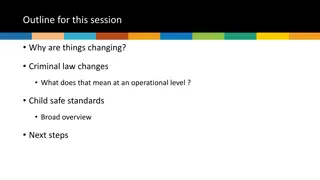The Importance of Play in Child Development
Play is essential for children as it aids in their overall development. From birth to 12 months, play activities like tummy time, reading books, and crawling help infants strengthen their muscles, improve cognitive skills, and foster emotional connections. The brain development during this period lays the foundation for future growth in social, cognitive, physical, emotional, and language areas. Parents and caregivers play a crucial role in supporting and engaging in these activities to enhance their child's learning experience.
Uploaded on Sep 28, 2024 | 0 Views
Download Presentation

Please find below an Image/Link to download the presentation.
The content on the website is provided AS IS for your information and personal use only. It may not be sold, licensed, or shared on other websites without obtaining consent from the author. Download presentation by click this link. If you encounter any issues during the download, it is possible that the publisher has removed the file from their server.
E N D
Presentation Transcript
The Importance of Play By: Ashley McLaren Wentzville R-IV Parent Educator
Play is Learning Your child loves to play. From the time your child was born they have been discovering what their body can do. Every time they play, your child s brain is making new connections that help their development. Developmental Areas Social Cognitive Physical Emotional Language
Birth to 12 Months *During the first year of a child s life, his brain will double in size. Much of this growth occurs in a part of the brain called the cerebellum, which is in charge of physical development and motor skills. This development helps babies learn to control their bodies and movement. They learn to hold up their heads, to roll over, grasp objects, and even to stand up. Meanwhile, the visual cortex, the part of the brain that helps us see, changes rapidly, and your baby starts to recognize faces. Next, the limbic structure, the part of the brain that controls emotion and long-term memory, begins to develop, helping your baby become more aware of the world around him *Urban Child Institute
Activities for Birth to 12 months Accordion Book This activity helps your child s vision develop with the high contrast colors and work on the importance of tummy time by giving them something to gaze at while they are in that position. It also can be your child s first experience with a book. Holding it and grabbing it works on fine motor skills and will encourage your child to practice picking up small items. Tummy time Tummy time is extremely important to your child s development. Through it your child is building upper body strength and neck strength. It can be done by placing your child on the floor on their tummy or by laying your child on your chest. It helps to provide your child with interaction during this time with toys or you joining them and talking with them. The goal is for your child to lift their head and chest up off the floor to see you and the toys.
Activities for Birth to 12 months continued Balls in a Bowl This activity is ideal for those young children who are working on sitting. It works on small muscle development in their hands as they grab the balls from the bowl. You can enhance this activity by talking about what your child is doing which gives them language. This is also a cause and effect activity which builds connections between neurons in the brain. Zip Top Bag Book Reading to your baby helps develop their receptive language. Your baby is understanding that pictures and illustrations stand for a thought. A picture of their caregiver reminds them of you. This skill is in early literacy concept.
Activities for Birth to 12 months continued Crawling *Crawling is the first and longest period of time that your baby will be putting weight through their hands to develop strength and stability at their shoulders. This is important because it allows them to have control of their hands for other skills such as: Feeding themselves Coloring Playing with toys Handwriting in the future Being able to get themselves dressed * www.nationwidechildrens.org
Crawling Continued *Crawling is considered the first form of independent movement. It helps develop and enhance our vestibular/balance system, sensory system, cognition, problem solving skills, and coordination. Allows for independent exploration Establishes body awareness in space so they know where they are and how to maneuver around their environment Teaches them an understanding of movement Builds responsibility for movement and mobility Provides a foundation for early problem solving skills Helps the left and right sides of their body work together for improved coordination Helps enhance depth perception www.nationwidechildrens.org
Activities for Birth to 12 months continued Walking Promoting Walking most children begin taking their first steps around 12 months. Some children may be closer to 14 months before taking their first step. Every child develops differently and on their own timeline. Promoting Walking Set the stage: baby proofing and providing baby with a safe environment Provide support: giving your baby a strong foundation with tummy time and then crawling gives them the core strength they will need to walk Go barefoot Reach high and low Cruise along
12 months to 24 months Development Although your child's physical growth will slow down in the second year, their development will continue at a rapid pace as they begin to explore the boundaries of their world. Here is a snapshot of your child's growth and development from 12 to 24 months of age. By the end of the second year, your child will probably have reached the following developmental milestones: Language using short phrases (2 to 4 words) understanding what common household objects are for (e.g., spoon, telephone, comb) following simple instructions pointing to objects when they are named (e.g., "Where's the dog?") * www.medbroadcast.com
Physical walking alone pulling toys behind them and pushing wheeled toys standing on tiptoe beginning to run kicking a ball scribbling or coloring on a piece of paper building a block tower (4 blocks or more) Cognitive starting to sort objects by color and shape climbing up and down on furniture (without help) going up and down the stairs (with support) Social/Emotional imitating the behavior of others starting make-believe play playing with other children (rather than just playing near them) www.medbroadcast.com
Activities for 12 months to 24 months Chips in a can This simple homemade activity develops fine motor skills by using their fingers to pick up the chips and the perceptual motor skills by using both her eyes and fingers to accomplish the task. It is also challenging them cognitively as they examine the can and chips and figure out how to get the chips into the slot. Parallel Talk and Self Talk This activity helps foster early language skills and gives your child a strong start into words and conversation. Joining your child on the floor with their favorite toy and talking with them about it. Parallel talk is explaining what they are doing with their toy. Self talk is you narrating what you are doing during the interaction with your child.
Activities for 12 months to 24 months continued Sensory Box This can be a chance for you and your child to be creative using beans, rice, birdseed or corn. Create a small size sensory box that your child can explore, scoop, dump and pour in. This allows your child to work on cognitive development skills like feeling different textures and hearing the sound of the material as they scoop and pour. It also works on motor development by helping them learn control with their muscles as they use tools to scoop and pour into containers. Tennis Ball Puzzle Grab a muffin tin and some tennis balls to create this activity. Your child will be developing motor skills using hand eye coordination to fit the ball into the muffin tin opening and completing their first puzzle. Cognitively they are starting the skill of one to one correspondence which is an early math concept. Your child will also learn problem solving skills when they have more tennis balls than spots.
36 Months and Older development in all areas is growing but not always at the same pace. Language development becomes more understandable for most and your child will be adding new words and talking in longer phrases daily. Cognitively they are starting to recognize and name familiar colors, sort objects by more than one characteristic and begin working with numbers and counting. Gross motor development skills like kicking, throwing and catching a ball begin to happen as does climbing both up and down steps independently. Fine motor skills like lacing, holding a pencil, and using scissors also develop. Socially and emotionally your child will start to have some control of and possibly even label their emotions, interact more with peers and show affection towards familiar people. Children at age three are sponges taking in EVERYTING around them. Their
Activities for 36 months and older Sorting sorting and recognizing differences is a developing skill. Helping your child by giving them the task of sorting socks from the laundry and making matches. Cognitively this increases your child s memory. This activity again aids with motor development as they pick up items and sort them. To add more of a challenge to the task encourage your child to use tongs to pick up the items. This will build muscles in their fingers to help with holding a pencil to write and holding scissors to cut. Sort anything coins, buttons, pom-poms canned food. At this age
Activities 36 months and older continued Cutting Using scissors is hard and can be frustrating for a 3 year old but developing good hand muscles and practicing regularly can build up the muscle memory. Get some children safety scissors and work with play dough to start. Roll the play dough out into a snake form and have your child simply snip it into small pieces. Next move to cardstock or craft foam and again just work on snipping small snips building up the muscles. Once your child has some experience and confidence move on to cutting through a straight line drawn on cardstock. Straws are also fun to cut because they tend to fly up as you snip them. Lastly trace some shapes onto card stock and encourage your child to cut out simple shapes like a
Activities for 36 months and older continued Racquet Play be worked on at age 36 months. Creating the racquet play activity gives children the opportunity to practice this skill even inside. While engaging with your child during this activity take time to use position words and describe where the balloon is headed. This increases your child s language and spatial awareness. Eye/hand coordination is a motor development that continues to
Activities for 36 months and older continued Sensory play Children at the age of three thrive on experiences and exploring new things. Allowing your child to explore through sensory play is a great way to develop their senses and help with sensory sensitivity. Play dough, water beads, shaving cream or finger painting allows them to experience different textures. Engaging in these experiences with your child is also helpful especially if your child tends to struggle with sensory sensitivity.


